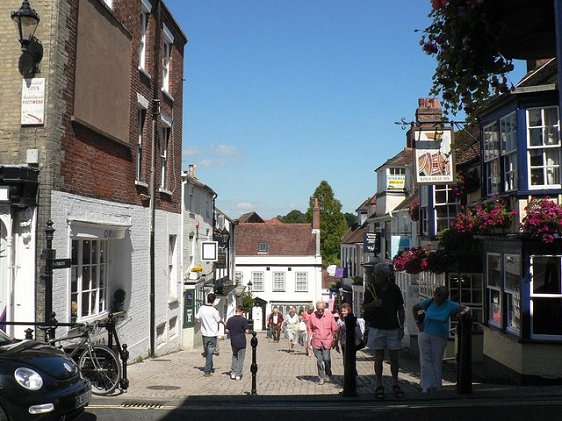 Lymington, Hampshire, England: Source: https://commons.wikimedia.org/wiki/File:Lymington,_down_Quay_Hill_-_geograph.org.uk_-_511278.jpg
Lymington, Hampshire, England: Source: https://commons.wikimedia.org/wiki/File:Lymington,_down_Quay_Hill_-_geograph.org.uk_-_511278.jpgAuthor: Chris Downer

Lymington is a port town in New Forest district, Hampshire, England. It is on the south coast of England, on the west bank of the Lymington River, across from Yarmouth on the Isle of Wight. The two towns are connected by ferry. Lymington has a population of 15,000 people (2012 estimate).
The history of human habitation in the Lymington area goes back to the Iron Age, based on the existence of an Iron Age fort called Buckland Rings in the area. The fort dates back to the 6th century BC.
Lymington was established by the Anglo-Saxons, probably in the 6th century. It was originally called Iimentun. The Domesday Book of 1086 recorded it as Lentune. Lymington received its market charter in the 13th century. The town developed a reputation for producing salt since the Middle Ages to the 19th century.
In the 18th and 19th century, Lymington was a military depot used by a number of foreign troops including the Germans, Dutch and French. Interestingly, the town was also a smugglers' haven, and stories abound of smugglers' tunnels under its High Street.
 Quay Street, Lymington: Source: https://commons.wikimedia.org/wiki/File:Quay_Street,_Lymington_-_geograph.org.uk_-_333909.jpg
Quay Street, Lymington: Source: https://commons.wikimedia.org/wiki/File:Quay_Street,_Lymington_-_geograph.org.uk_-_333909.jpgAuthor: Gillian Moy

Visiting Lymington
From London, take the M3 motorway until it connects to the M27 motorway at Junction 14. Head west on the M27Places of Interest in Lymington
- Buckland Rings: An Iron Age hill fort, one of the best preserved lowland ancient site in the Hampshire/Dorset basin.
 Latest updates on Penang Travel Tips
Latest updates on Penang Travel Tips

Copyright © 2003-2025 Timothy Tye. All Rights Reserved.

 Go Back
Go Back